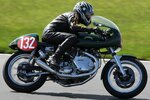Roy, its not a thing of length of pushrods or spindles that is my concern. Just that the engine case is alu with all positions of spindles and camshafts. When you mount a steady plate over them that is not alu , positions will not remain same as alu got twice the expansion than steel, stainless is a bit better but still way less. So in effect there will be side loads on spindles and shafts, so no longer perpendicular like in cold condition - unless you can work out all positions in engine case in hot condition and machine holes in steel plate for hot state . Not soo easy to do, on a mill with DRO allright to find positions, with hot case then. So for a workaround I just got alu 7075 and no more worries about heat growth. I could not see much of advantage in steel, so no headache. You got two part steady plates , a bit better maybe. I prefer one piece plate and not much of windows in it, looks more solid to me as less flexible from loads. But don´t ask me for calculations about this matter, I am quite useless in maths of that kind.
Stainless for pushrods is better than plain steel but still not quite to the point. We got all alu engine components in Vincents. Allright, the pushrods are very short, that helps. But you really want alu for keeping valve clearance in hot engine as good as possible for enjoying the quieting ramps on cams - if there were any with original . That is the reason why you set nil in cold engine as this is all you can do, no negative "clearance" possible. Sure, there is more than one place in the engine that can be noisy but once you know about this aspect you may want to improve things if you can.
Vic

